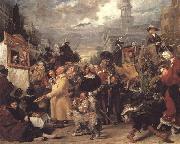Wholesale Oil Painting No Minimum |
|||||||||||
|
|
|||||||||||

|
|||||||||||
|
|
|
||||||||
Benjamin Robert HaydonEnglish Romantic Painter, 1786-1846 1786-1846.was an English historical painter and writer. Haydon was born at Plymouth. His mother was the daughter of the Rev. Benjamin Cobley, rector of Dodbrooke, near Kingsbridge, Devon. Her brother, General Sir Thomas Cobley, was renowned for his part in the siege of Ismail. Benjamin's father, a prosperous printer, stationer and publisher, was well known in Plymouth. Haydon, an only son, at an early date showed an aptitude for study, which was carefully fostered by his mother. At the age of six he was placed in Plymouth grammar school, and at twelve in Plympton St Mary School, the same school where Sir Joshua Reynolds had received most of his education. On the ceiling of the school-room was a sketch by Reynolds in burnt cork, which Haydon loved to sit and look at. Whilst at school he had some thought of adopting the medical profession, but he was so shocked at the sight of an operation that he gave up the idea. Reading Albinus inspired him with a love for anatomy; but from childhood he had wanted to become a painter. Full of energy and hope, he left home, on 14 May 1804, for London, and entered the Royal Academy as a student. He was so enthusiastic that Henry Fuseli asked when he ever found time to eat. Aged twenty-one (1807) Haydon exhibited, for the first time, at the Royal Academy, The Repose in Egypt, which was bought by Thomas Hope the year after for the Egyptian Room at his townhouse in Duchess Street. This was a good start for the young artist, who shortly received a commission from Lord Mulgrave and an introduction to Sir George Beaumont. In 1809 he finished his well-known picture of Dentatus, which, though it increased his fame, resulted in a lifelong quarrel with the Royal Academy, whose committee had hung it in a small side-room instead of the great hall. That same year, he took on his first pupil, Charles Lock Eastlake, later destined to become one of the great figures of the British art establishment. In 1810 his financial difficulties began when the allowance of £200 a year from his father was stopped. His disappointment was embittered by the controversies in which he now became involved with Beaumont, for whom he had painted his picture of Macbeth, and Richard Payne Knight, who had denied the beauties as well as the money value of the Elgin Marbles. |
||||||||
|
|
||||||||
Punch or May Day
Punch or May Day Painting ID:: 28153 |
1829
oil on canvas 150.5 x 185.1 cm
(59 1/4 x 72 1/2 in)
Tate Gallery London (mk63) 1829 oil on canvas 150.5 x 185.1 cm (59 1/4 x 72 1/2 in) Tate Gallery London (mk63) |
|||||||
|
CONTACT US |

